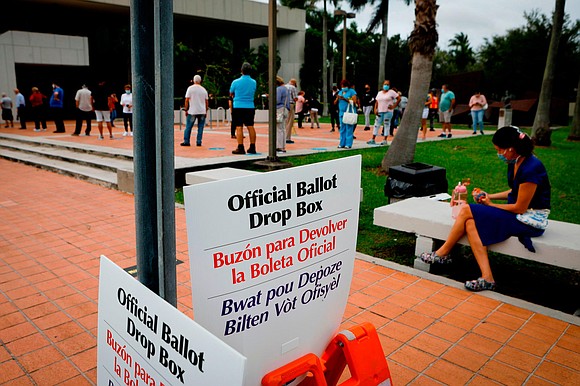Republicans are narrowing the early voting gap in these states
CNN/Stylemagazine.com Newswire | 10/29/2020, 2 p.m.

By Adam Levy, Ethan Cohen and Liz Stark, CNN
(CNN) -- In four key states -- Florida, North Carolina, Nevada and Iowa -- Republicans are beginning to narrow the Democratic advantage in pre-Election Day voting.
More than 12 million ballots have been cast in these four states, which could be crucial in determining the next president.
The candidates' schedules reflect the focus on these states. President Donald Trump and former Vice President Joe Biden were both in Florida on Thursday campaigning for the state's 29 electoral votes. Later, Trump was set to travel to North Carolina, while Vice President Mike Pence was scheduled for campaign stops in Iowa and Nevada. Biden is due in Iowa on Friday.
With five days until November 3, here's a deeper look at who's already voted in these key states, with data from Catalist, a company that provides data, analytics and other services to Democrats, academics and nonprofit issue-advocacy organizations
Florida
Trump won Florida by slightly over one percentage point last cycle.
In the last week, voters under 30 have slightly increased their share of Florida's early voting electorate, from 8% to 10%. Other age groups have also seen small increases, further diminishing the dominance of Florida's senior voters 65 or older, who made up 45% of early voters a week ago, but now make up only 39%.
Florida's early voting electorate is slightly more diverse than at this time four years ago. Hispanic voters' share of the pre-Election Day vote has increased from 14% four years ago to 16% now, and Black voters' share has ticked slightly up from 12% then to 13% now. The vote from White voters is down three points from this point in 2016.
Republicans are narrowing the gap in pre-election ballots cast. Democrats currently lead by four points. A week ago, it was nine points. Party advantage is not predictive of outcome -- but nationwide polling shows many Republicans also prefer voting in person on Election Day rather than early.
North Carolina
Trump won the Tar Heel State by more than three percentage points in 2016.
Young people are continuing to vote in large numbers in North Carolina. Last week, voters under 30 made up about 11% of early voters but that's now ticked up slightly to over 12%.
Democrats have lost some of their lead in the pre-election vote. Last week, they had a 12-point advantage over Republicans in ballots cast. Currently, it stands at eight points.
By race, White voters account for the majority of ballots already cast in North Carolina at 72%, followed by Black voters with the second largest share of those ballots at 22%. This remains nearly identical to the racial composition of the early voting electorate four years ago.
Iowa
Iowa remains a competitive battleground this cycle after Trump won the Hawkeye State by more than nine percentage points in 2016. The state also has a key Senate race between incumbent Republican Joni Ernst and Democratic challenger Theresa Greenfield.
Democrats continue to cast pre-election ballots at a much higher rate than Republicans, similar to 2016. At 49% of the pre-election vote, Democrats have a 17-point lead over Republicans, who stand at 32%. Republicans, however, have slightly narrowed that gap over the last week by four points.
By race, Iowa's current pre-Election Day electorate is similar to this point in 2016, with White voters comprising the vast majority of early voters at 94%.
Iowa hasn't seen as large a shift in age breakdown as some other states. Voters under 30 make up 10% of all early voters -- up only three points from this time four years ago. Voters 30-64 are up five points from 42% of turnout at this point four years ago to 47% now. Voters 65 and older make up a smaller share of early voters than at this point four years ago.
Nevada
Nevada had a narrow margin of defeat for Trump four years ago, with about two percentage points separating him from Hillary Clinton.
Nevada's early voting electorate is trending younger compared to the last week. Eleven percent of voters so far are under 30; last week it was only 9%. Voters 65 or older have gone from 40% of early voters last week to 35% now.
About two-thirds of Nevada's pre-election ballots come from White voters, which is a small decrease from 70% four years ago. Hispanic voters make up the second largest share of those ballots at 13%, a slight uptick from in 2016. Black voters and Asian voters have also seen one-percentage-point increases in their shares of the early vote.
Republicans are narrowing the Democratic advantage in the pre-election vote. Last week, Democrats led Republicans by 12 points. As more ballots have been returned in the vote-by-mail state, the 42% of ballots cast by Democrats is now only seven points higher than Republicans' 35%.
CORRECTION: This story has been updated to reflect Trump's 2016 defeat in Nevada.





